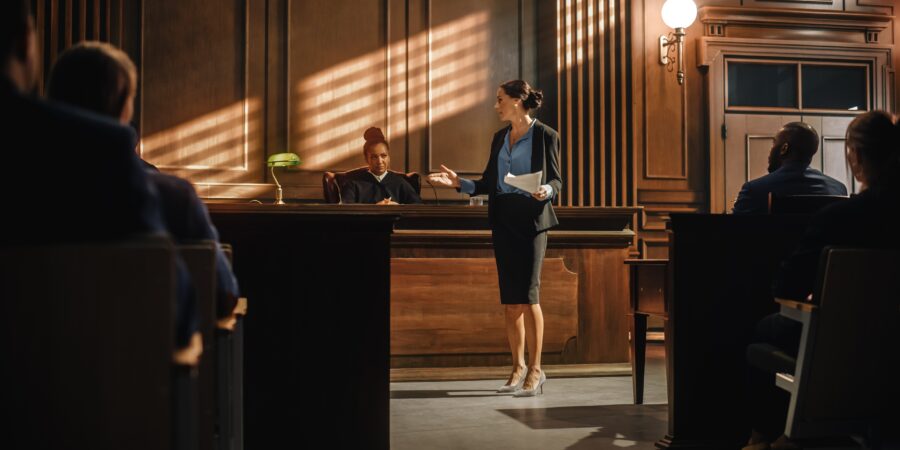Trial Process for a Personal Injury Case
When a California personal injury case goes to trial, a judge or a jury will determine its fate. The court will decide whether there is enough evidence to clearly show that the defendant caused injury to the plaintiff that resulted in certain losses.
The trial provides the plaintiff with an impartial forum in which to air their grievances and resolve them fairly. The goal of a plaintiff who files a personal injury claim is to convince the court that a judgment against the defendant is warranted.
The defendant has an opportunity to speak on their own behalf and to present evidence that refutes the claims of the plaintiff.
When both parties have made their cases, the judge or jury will weigh the evidence at hand and decide if the defendant is to blame for harming the plaintiff. If the court rules in favor of the plaintiff, it must also decide on the compensation amount to which that plaintiff is entitled.
What Happens During a Trial?
Trials usually involve six distinct phases:
- Jury selection
- Opening statements
- Witness testimony and cross-examination
- Closing arguments
- Jury instructions
- Jury deliberation and reaching a verdict
Jury Selection
Potential jurors are interviewed by the judge, the plaintiff and the defendant. Ideal jurors are judged as impartial, objective and unbiased about the content of the lawsuit.
Jurors who are heavily invested in one side of the argument or the other may be excused from jury duty under a challenge for cause. A peremptory challenge can also be used by either side to exclude potential jurors with no explanation whatsoever.
Opening Statements
The opening statements delivered at the start of the case are persuasive but limited to the facts. The introduction of evidence and witness testimony comes later, and the arguments come at the end.
During the opening statements, the plaintiff’s personal injury attorney and the lawyer representing the defendant are given an opportunity to introduce the jury to the core dispute at hand.
The parties tell the jurors who their witnesses are and how those witnesses are related to the parties. The jury is told what the witnesses are expected to say on the witness stand and how the trial will proceed.
The plaintiff usually speaks first, and their opening statements are longer. They must show that the defendant is legally liable for their injuries.
The plaintiff describes the facts surrounding their injuries and how the defendant is responsible. The plaintiff tells the jury how they will show enough cause against the defendant to obtain a civil judgement.
The defendant then tells the jury their version of events which may or may not be based on an affirmative defense. In an affirmative defense, the defendant admits wrongdoing. However, they claim that because they had a good reason for doing wrong, they should be exempt from any liability resulting therefrom.
When three different plaintiffs sue a single defendant or one plaintiff sues two different defendants, the lawyers representing the parties may add their own opening statements to the mix.
Witness Testimony and Cross-Examination
During this part of the trial, the parties introduce key evidence and arguments to substantiate their claims. The plaintiff presents evidence to show that the defendant is responsible for their injuries.
The plaintiff may produce witnesses and experts to substantiate their claims. They might also present physical evidence like photos, medical reports and supporting documents and materials.
In complex cases involving defective products or medical malpractice, compelling testimony from experts and convincing evidence are crucial in determining a defendant’s responsibility for the plaintiff’s injuries.
Witness testimony typically has four phases:
- The plaintiff calls a witness to the stand who swears to tell the truth.
- Using a question-and-answer format with the witness, the plaintiff introduces information that strengthens the plaintiff’s case.
- The defendant cross-examines the witness and attempts to discredit them.
- During redirect examination, the plaintiff questions the witness again and performs damage control on any information presented during cross-examination that could damage the plaintiff’s position.
After the plaintiff completes witness testimony, it rests its case. The defendant can now introduce evidence to debunk or downplay the plaintiff’s allegations. The defendant will present evidence showing that it is not responsible for harms suffered by the plaintiff.
After the defense rests, the plaintiff can respond to the defendant via rebuttal without introducing new arguments or evidence. The defense might then rebut the plaintiff’s rebuttal, and after that, both sides rest.
Closing Arguments
During this phase of the trial, each party tries to convince the jury that they have a preponderance of the evidence. Under the preponderance standard, the plaintiff has the burden of proof in PI cases. He or she must convince the jury that there is at least a 50 percent chance that their allegations are true.
Instructing the Jury
The judge will explain the legal standards that should govern the jury’s deliberations and final verdict. This process typically includes input from both parties.
Jury Deliberation and Verdict
During deliberation, the jurors reach agreement as to whether the defendant is responsible for the plaintiff’s injuries. If the jury decides in favor of the plaintiff, they must agree on how much compensation the plaintiff will receive for injuries suffered.
Jury deliberations can last for a few hours or a few weeks. In California, personal injury claims are civil remedies that require only nine out of 12 jurors to reach an agreement.
Filing a Personal Injury Claim
There are certain criteria you must meet in order to sue for personal injury damages:
- Standing: You must be directly affected by the legal dispute described in your claim. In a PI claim, you must be the injured party.
- Natural person or legal person: A human being is a natural person who is considered a legal entity. A corporation is a nonhuman legal entity that is considered a legal person. You must be a legal person or a natural person to start a lawsuit.
- Legal capacity: To file suit, you must have the legal capacity to do so. If you are legally disabled, then your suit must be brought by a legal representative acting on your behalf. Legally disabled persons include kids under the age of 18 or persons who have been judged as mentally incompetent due to illness, age or infirmity.
- An identified defendant: You must have someone or something to sue. Tracking down the responsible parties can require some detective work.
Why Do PI Lawsuits Go to Trial?
Most PI claims are resolved well before the case goes to trial. In fact, a settlement negotiated by the parties often occurs before a claim is filed. PI cases can also be resolved by way of alternative dispute resolution or arbitration and mediation.
If you are pursuing a claim on your own without the representation of a personal injury attorney, your settlement offer is likely to be as low as possible, even if it sounds generous on the face of it.
In such cases, retaining a personal injury attorney and going to trial may be the only way to negotiate a fair settlement. Parties go to trial when they believe they can win. However, you could also suffer a big loss. Taking a case to trial is essentially a gamble.
To File or Not to File?
Before pursuing a claim, you should consult with an experienced PI lawyer about these key considerations:
The Strength of Your Case
- How does your case compare to similar cases?
- What were the outcomes of those cases?
- What is the probability of winning at trial?
- How strong is your evidence?
- How strong is the defendant’s evidence?
Your Settlement Requirements
- How much does your attorney think your case would be worth at trial?
- What is your minimum settlement amount?
- What are the liability limits on the defendant’s insurance coverage?
- Do you have sufficient financial resources?
- What would be your income tax liability on any given settlement amount?
Potentially Adverse Consequences
- Will a trial generate unfavorable publicity?
- Could your personal information be exposed during a trial?
- Are you willing to wait out a long trial?
- Is the defendant willing to negotiate?
Statute of Limitations for California PI Claims
- Under the statute of limitations, you have two years from the date you were injured to file a claim.
- If you file after two years, the court is unlikely to hear your case.
- You will forfeit your right to compensation unless you can show that extenuating circumstances prevented you from taking action before the statute of limitations ran out.
Never accept a settlement offer without first consulting a personal injury lawyer. You have everything to lose and little to gain if you settle for less than your claim is worth.



